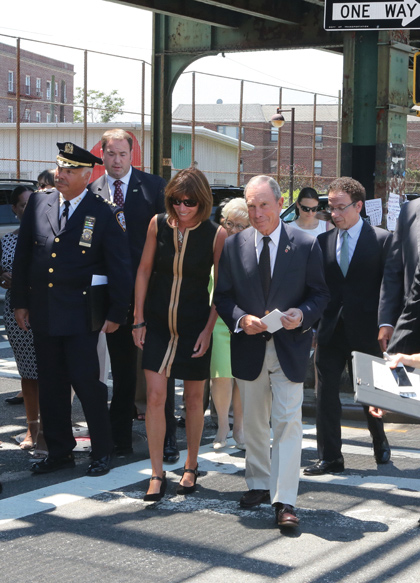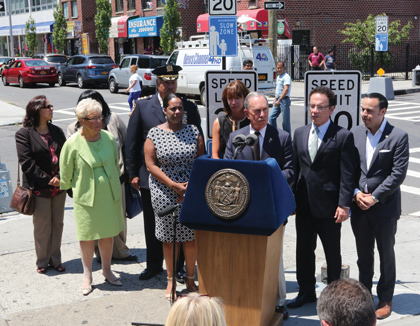
MAYOR BLOOMBERG, COMMISSIONER SADIK-KHAN ANNOUNCE NEW NEIGHBORHOOD SLOW ZONES TO COMBAT SPEEDING AND FURTHER IMPROVE RECORD TRAFFIC SAFETY
Residential Speed Limit Reduced from Standard 30 M.P.H to 20 M.P.H.
Traffic Calming Measures is designed to Reduce Speeds in 13 Residential Areas with Nearby Schools, Senior Centers With Record Lows in Traffic Fatalities,
City Continues Effort to Combat the Single Largest Cause of Fatal Crashes: Speeding

Photos: Spencer T Tucker
Mayor Michael R. Bloomberg and Department of Transportation Commissioner Janette Sadik-Khan announced an expansion of the City’s Neighborhood Slow Zone program which reduces the speed limit from 30 miles per hour to 20 miles per hour in residential neighborhoods. It also adds traffic calming measures to reduce speeding and improve safety on local streets.
The program builds on the City’s aggressive efforts to curb speeding which helped bring traffic fatalities to the lowest levels in recorded history in 2011 and made the last four years the safest period in city history. The 13 new areas have been preliminarily selected for implementation of Slow Zones.
The locations, which currently are in the design and approval process, were all initially requested by local applicants and were evaluated based on crash history, community support, proximity of schools, senior centers and daycare centers among many additional criteria.
The city’s first ever neighborhood Slow Zone was installed in November 2011 in the Claremont section of the Bronx. The Mayor and Commissioner made the announcement in Corona, Queens, a community with significant pedestrian traffic that speeding drivers often use as a short cut. They were joined by NYPD Chief of Transportation Bureau James Tuller, Borough President Helen M. Marshall, Assembly member Francisco P. Moya, Council Member Julissa Ferreras, Council Member James Vacca and Giovanna Reid, District Manager of Community Board 3 which unanimously supported the implementation of the Slow Zone in a vote last Thursday.
“We’ve driven fatalities and injuries down to record lows through innovative traffic engineering, aggressive enforcement and an unwavering commitment to finding new ways to make our streets safer as even one fatality is too many,” said Mayor Bloomberg. “We are continuing our assault on the number one traffic killer: speeding. We’ve seen success already where we have installed Slow Zones and we expect safety will improve as speeding is reduced in these communities.”

“Our neighborhoods are where New Yorkers live, where they go to school, where they play and where they pray,” said Commissioner Sadik-Khan. “Our residential streets need to be drawn to this human scale, and by simply reducing the speed of passing cars by 10 miles per hour we can save lives as we make the streets people walk along more inviting.”
“The addition of this slow zone in North Corona, where we have heavy pedestrian traffic particularly from students, seniors, and families, is a needed safety precaution,” said Council Member Ferreras. “As part of our ongoing work to curb the number of accidents due to speeding and heavy traffic, we must remember that the safety of the pedestrians should come first, and Slow Zones are an effective tool to help protect our community.”
“Our streets are not for drag racing,” said Council Member James Vacca, Chair of the Transportation Committee. “They are where we raise our children, shop at local establishments, and say hello to our neighbors. I commend DOT's commitment to this program which lets speeders know that they cannot use our streets as their own private speedways and if they do, they will face consequences.”
“Speeding is the number one cause of car crashes and is a detriment to the well being of pedestrians, bicyclists, and drivers alike,” said Assembly member Deborah J. Glick, who is sponsoring the City’s Speed Camera legislation. “I am proud to support legislation that will hold speeders accountable for their actions and I am glad that the City is taking additional steps to ensure the safety of all communities.”
The 13 locations preliminarily selected for implementation of a Slow Zone are:
Slow Zones are marked by:
To continue to reduce traffic crashes on residential streets, Neighborhood Slow Zones were first announced in 2010 as part of the Department of Transportation’s Pedestrian Safety Study and Action Plan.
In the Claremont, Bronx Slow Zone, the first zone installed, preliminary data shows reduced speed at six out of seven locations where speed bumps have been installed and top speeds already have been reduced by approximately 10 percent.
Criteria considered in evaluating the Slow Zone applications included crash rates, community support, number of local schools, senior centers, day care centers, subway stations and distinct boundaries. Areas that included fire stations, hospitals, truck routes were avoided and the amount of bus routes were kept to a minimum inside the proposed zone.
Traffic Safety Gains Since 2001
The number of annual traffic fatalities in New York City has declined from 393 fatalities in 2001 to an all time record low of 243 fatalities in 2011 – a 38 percent reduction.
This includes reductions in vehicle and pedestrian fatalities, and cyclists fatalities have remains stable despite the number of cyclists quadrupling since 2001. The first year traffic fatality records were kept in New York City was 1910.
The number of crashes with any injury has declined severely, from 79,518 in 2001 to approximately 53,870 in 2010, a difference of 25,648 fewer injury crashes per year. Final 2011 data is still being tabulated, but 2011 injury crash totals are expected to decline to below the 2010 level.
According to National Highway Traffic Safety Data, New York City has the lowest traffic rate of any of the top ten largest cities in the United States with an average rate of 3.3 fatalities per 100,000 residents over the last three years.
The Administration continues to improve street safety engineering in all five boroughs including the addition of nearly 10,000 pedestrian countdown signals at more than 1,800 intersections in all five boroughs announced last year and installing more than 1,700 speed bumps citywide.
Additional Slow Zone Details
The Corona location, which covers .26 square miles, is bordered by 34th Avenue to the north, 108th street to the east, Roosevelt Avenue to the south, and Junction Boulevard to the west averaged more than 33 injuries per year. It contains two schools as well as 10 pre-K/daycare/Head Start centers.
The Corona, Inwood, Mt. Eden and New Brighton/St. George Slow Zones are all scheduled to be implemented this year.
The Department of Transportation will continue to accept requests for Slow Zones from local communities and will select appropriate locations to present to Community Boards for approval. The department plans to reopen the application process again in 2013. For more information, including the criteria for establishing a neighborhood Slow Zone, visit www.nyc.gov.